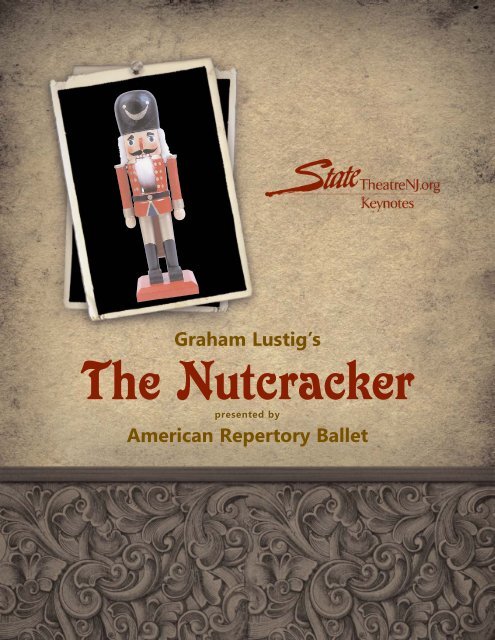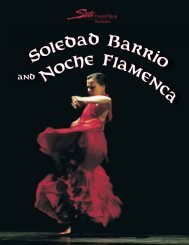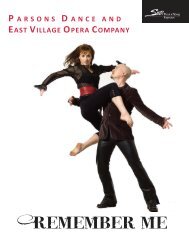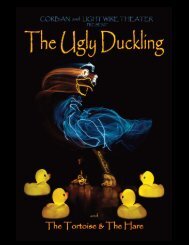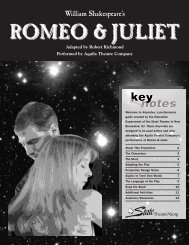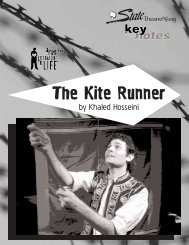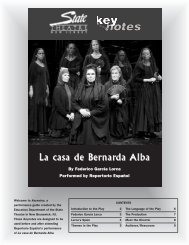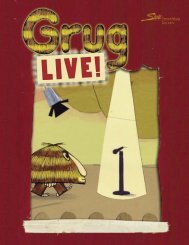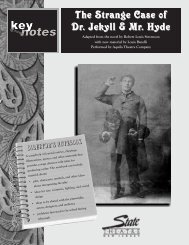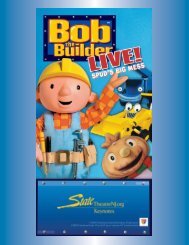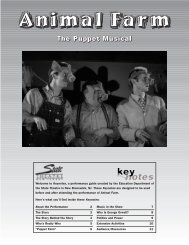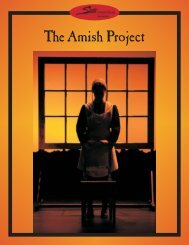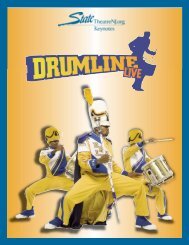The Nutcracker - State Theatre
The Nutcracker - State Theatre
The Nutcracker - State Theatre
Create successful ePaper yourself
Turn your PDF publications into a flip-book with our unique Google optimized e-Paper software.
Graham Lustig’s<br />
<strong>The</strong> <strong>Nutcracker</strong><br />
present<br />
presented ed by<br />
American Repertory Ballet
Welcome! 2<br />
<strong>The</strong> <strong>State</strong> <strong>The</strong>atre in New Brunswick, New Jersey<br />
welcomes you to the school-day performance of <strong>The</strong><br />
<strong>Nutcracker</strong>. We’re delighted to have you experience<br />
American Repertory Ballet’s fully-staged, full-length<br />
production of this popular story ballet.<br />
<strong>The</strong>se Keynotes provide information and activities<br />
that will help you follow and enjoy the show. We hope<br />
it will also help you find connections between what you<br />
see on the stage and your own personal experience.<br />
Look for the ballet shoes next<br />
to activities and discussion<br />
questions.<br />
CONTENTS<br />
Welcome/Acknowledgements....................................................2<br />
<strong>The</strong> Story ........................................................................................3-4<br />
A History of <strong>The</strong> <strong>Nutcracker</strong> ........................................................5<br />
About This Production ..................................................................6<br />
In the Land of Sweets ....................................................................7<br />
Ballet Basics........................................................................................8<br />
Talking Ballet ....................................................................................9<br />
Activity: Design a Set ..................................................................10<br />
<strong>Nutcracker</strong> Crossword ................................................................11<br />
More to Do......................................................................................12<br />
Getting Ready for the Show......................................................13<br />
Puzzle Solutions ............................................................................14<br />
Keynotes are made possible by a<br />
generous grant from Bank of<br />
America Charitable Foundation.<br />
<strong>The</strong> <strong>State</strong> <strong>The</strong>atre’s education program is funded in part by Bank of America Charitable Foundation,<br />
Bristol-Myers Squibb, Brother International Corporation,<strong>The</strong> Horizon Foundation for New Jersey,<br />
Johnson & Johnson Family of Companies, the John F. Kennedy Center for the Performing Arts, J. Seward<br />
Johnson, Sr. 1963 Charitable Trust, <strong>The</strong> Blanche and Irving Laurie Foundation, McCrane Foundation,<br />
MetLife Foundation, Mid Atlantic Arts Foundation, National Starch and Chemical Foundation, Inc., PNC<br />
Foundation, Provident Bank Foundation, Robert Wood Johnson Foundation, Verizon, and Wachovia<br />
Foundation. <strong>The</strong>ir support is gratefully acknowledged.<br />
Funding has been made possible in part by<br />
the New Jersey <strong>State</strong> Council on the<br />
Arts/Department of <strong>State</strong>, a partner agency<br />
of the National Endowment for the Arts.<br />
Continental Airlines is the<br />
official airline of the <strong>State</strong><br />
<strong>The</strong>atre.<br />
Keynotes are produced by the Education<br />
Department of the <strong>State</strong> <strong>The</strong>atre, New<br />
Brunswick, NJ.<br />
Wesley Brustad, President<br />
Lian Farrer, Vice President for Education<br />
Keynotes for <strong>The</strong> <strong>Nutcracker</strong> written and<br />
designed by Lian Farrer, edited by Katie Pyott<br />
© 2008 <strong>State</strong> <strong>The</strong>atre<br />
<strong>Nutcracker</strong> set and costume designs by Zack<br />
Brown.<br />
<strong>The</strong> <strong>State</strong> <strong>The</strong>atre, a premier nonprofit venue<br />
for the performing arts and entertainment.
<strong>The</strong> Story 3<br />
Graham Lustig, the American Repertory Ballet’s artistic director, created this production of <strong>The</strong> <strong>Nutcracker</strong>. In the story<br />
below, are there any details that are different from other versions of the story you have seen or read? What’s different?<br />
Act I: <strong>The</strong> Party<br />
<strong>The</strong> year is 1915 and Marie, her family, and friends have just<br />
finished eating a big Christmas Eve dinner, ending with heaps of cakes<br />
and sweets. Father and his friends have stepped outside for a breath of fresh<br />
air, and Mother is still seated at the table chatting with Aunt Edith and her<br />
friends.<br />
As everyone comes back inside to warm up, Marie watches as a young<br />
cadet (soldier in training) pays attention to her beautiful older cousin,<br />
Vera. Marie dreams of a time when she, too, will enjoy the attentions of<br />
a gallant young man. Aunt Edith is horribly teased by Marie’s naughty<br />
brother Fritz, who pesters her with a pet rat that he stole from the<br />
pocket of one his cousins.<br />
As the children begin quarreling, Uncle Drosselmayer draws<br />
their attention by announcing that it is time to open the<br />
Christmas presents. Before the children open the gifts, they watch a special<br />
Marie<br />
entertainment that has been arranged by Uncle Drosselmayer. First, two tiny clown<br />
dolls delight everyone. <strong>The</strong>n Fritz gives a demonstration of his sword skills.<br />
At last the presents are opened. Marie is surprised and delighted with her<br />
unusual gift: a nutcracker. Fritz and his two friends tease Marie and snatch away<br />
her nutcracker. In an instant it is broken. <strong>The</strong> nanny is there to give some of her special<br />
healing to the situation and soon everyone is happy again.<br />
Has it all been a Dream?<br />
Marie looks back to see everyone suddenly hidden by the giant curtain. She<br />
cannot believe her eyes when two rats appear, dressed just like her party<br />
friends. Soon other rats emerge, searching for cake crumbs. Marie is so<br />
the Rat King<br />
terrified that she faints. Uncle Drosselmayer appears and tenderly<br />
places her on the sofa, where her dreams carry her to a magical<br />
kingdom.<br />
<strong>The</strong> Battle<br />
Marie dreams that the Rat King has taken possession of the<br />
cake and that the toy soldiers, led by the <strong>Nutcracker</strong>, are battling<br />
for victory. When the <strong>Nutcracker</strong> is captured, only she can help<br />
him escape. She stabs the Rat King so badly that the<br />
<strong>Nutcracker</strong> is set free. Fearing that the <strong>Nutcracker</strong> is<br />
injured, Marie cradles him in her arms. Suddenly he<br />
turns from wood into a handsome young prince.
<strong>The</strong> Story 4<br />
Marie and the Prince leave the Frozen Forest.<br />
In <strong>The</strong> Frozen Forest<br />
<strong>The</strong> Prince leads Marie to the Frozen<br />
Forest. In this place live beautiful snow<br />
maidens and adorable snowballs who<br />
entertain her with their skating dance. A<br />
balloon shaped like a Christmas<br />
ornament transports Marie and the<br />
Prince to a faraway magical kingdom.<br />
Act II: <strong>The</strong> Land of Sweets<br />
Marie and the Prince arrive in a lovely land of candy<br />
and sweets, where they are greeted by the Sugar<br />
Plum Fairy and her cavalier. After the bonbons<br />
have entertained Marie with their dancing,<br />
three tiny mice leap from the throne. <strong>The</strong><br />
Prince captures them. He is about to slice<br />
off their tails when Marie begs him to<br />
stop.<br />
Pleased that Marie has saved the<br />
mice, the Sugar Plum Fairy arranges<br />
a command performance. Marie<br />
is charmed by the many<br />
wonderful entertainers who come<br />
from Spain, China, Arabia, Russia,<br />
and Germany to dance for her. <strong>The</strong> Prince<br />
presents Marie with a beautiful bouquet of<br />
dancing flowers. Mother Ginger and her<br />
little clowns are full of fun and mischief.<br />
Finally the Sugar Plum Fairy and her<br />
cavalier create a dazzling display. As the<br />
dream draws to a close, Marie suddenly<br />
feels so sleepy that she can barely keep her eyes open.<br />
Back at Home<br />
production designer<br />
Zack Brown’s sketch<br />
for the Sugar Plum<br />
Fairy’s costume<br />
Uncle Drosselmayer escorts Marie back to the safety of home and the<br />
comfortable sofa where her journey began. When Marie awakens, her<br />
thoughts are spinning with the happy memories of her amazing<br />
adventure while she still holds in her arms her precious <strong>Nutcracker</strong>.<br />
Exploring<br />
the Ballet<br />
Ballet dancers tell stories without using<br />
any words. Working in a small group with<br />
some of your classmates, pick one part of<br />
the <strong>Nutcracker</strong> story to act out without<br />
speaking. Be sure to include the nonhuman<br />
characters such as the mice and<br />
the snowballs. After rehearsing your<br />
group’s part, put all the groups together<br />
for a performance of the whole story.<br />
Create a travel poster for the Land of<br />
Sweets. What words and pictures can you<br />
put on your poster to make people want<br />
to visit there?<br />
Fun F ac t:<br />
Sugarplums were a traditional<br />
Christmas treat in England for<br />
hundreds of years. Not actually<br />
made from plums, they were small,<br />
plum-shaped candies made from<br />
nuts or seeds coated in several<br />
layers of sugar.
A History of <strong>The</strong> <strong>Nutcracker</strong> 5<br />
In 1816, the German writer E.T.A. Hoffmann published <strong>The</strong> <strong>Nutcracker</strong><br />
and the Mouse King, a frightening story involving a bloody battle<br />
between a nutcracker and a seven-headed mouse. He wrote it for adults,<br />
and did not intend it for children. In 1844 Alexandre Dumas (the author<br />
of <strong>The</strong> Three Musketeers) adapted Hoffmann’s<br />
ADAPT - to change story for younger audiences.<br />
something so it can be It was Dumas’ version of the story that<br />
used for a specific sparked the interest of Marius Petipa, the<br />
purpose or for a senior ballet master of the Russian Imperial<br />
specific audience Ballet. He hired the Russian composer Pyotr<br />
Ilyich Tchaikovsky to write a score for the<br />
SCORE - the music<br />
production. <strong>The</strong> choreography was created<br />
written for a ballet,<br />
by Petipa and Lev Ivanov. <strong>The</strong> first<br />
play, film, opera, or<br />
performance of their new <strong>Nutcracker</strong> ballet<br />
other performance<br />
was on December 18, 1892 in St. Petersburg,<br />
CHOREOGRAPHY - Russia. <strong>The</strong> audience and critics did not like it<br />
the steps, body very much at first.<br />
movements, and<br />
<strong>The</strong> <strong>Nutcracker</strong> was not performed outside<br />
patterns used in a of Russia until 1934. It was first presented in<br />
dance<br />
the U.S. in 1944, by the San Francisco Opera<br />
Ballet, with new choreography by Willam<br />
Christensen. One of the most famous productions of the ballet was<br />
created by the New York City Ballet in 1954, choreographed by George<br />
Balanchine. Since then, <strong>The</strong> <strong>Nutcracker</strong> has become one of the bestloved<br />
performances of the Christmas season. Hundreds of ballet and<br />
theater companies all over the world perform it every year. American<br />
Repertory Ballet’s <strong>Nutcracker</strong>, with choreography by Graham Lustig,<br />
premiered in 2000.<br />
Write a<br />
Review<br />
Though it is one of the most popular<br />
ballets today, <strong>The</strong> <strong>Nutcracker</strong> was not very<br />
successful when it was first performed in<br />
1892. One critic wrote:<br />
For dancers there is little in it, for art<br />
absolutely nothing, and for the artistic<br />
fate of our ballet, one more step<br />
downward.<br />
After you see the performance, write<br />
your own review. Do the words of the 1892<br />
reviewer above reflect the production that<br />
you saw at the <strong>State</strong> <strong>The</strong>atre? Include<br />
comments on the music, the dances and the<br />
costumes, and be sure to explain why you<br />
liked or disliked a particular part of the<br />
show.<br />
About the Composer<br />
Pyotr (Peter) Ilyich Tchaikovsky (1840-1893) was a Russian composer, conductor, and music<br />
professor. He began writing music at age 14 and went on to compose operas, symphonies,<br />
piano and violin concertos, and other pieces. He is considered by many to be the greatest<br />
composer of music for ballet. In addition to <strong>The</strong> <strong>Nutcracker</strong>, Tchaikovsky also wrote the<br />
music for the ballets Swan Lake and Sleeping Beauty.<br />
During his lifetime, Tchaikovsky become enormously popular throughout Europe and abroad. On a concert tour of<br />
America in 1891, he conducted some of his music at the very first performance at New York’s Carnegie Hall. Despite his<br />
success, Tchaikovsky suffered from anxiety and depression. Some scholars believe that his death—he died of cholera after<br />
drinking contaminated water—was a suicide, though this is impossible to prove.<br />
Truly there would be a reason to go mad were it not for music.<br />
—Tchaikovsky
About This Production 6<br />
One of the important ways that a live performance is<br />
different from a movie or a television show is that a live<br />
show is different every time it is performed. Even if you<br />
have seen <strong>The</strong> <strong>Nutcracker</strong> before, this performance will<br />
not be quite the same.<br />
Every ballet company that decides to create a<br />
production of <strong>The</strong> <strong>Nutcracker</strong> begins with the same<br />
music and the same basic story, but then they make it<br />
their own. <strong>The</strong>y design new sets, costumes, and lighting.<br />
<strong>The</strong>y may decide to leave out parts of the story or<br />
change the order of the dances. Most importantly, their<br />
choreographer creates new movements for the dancers.<br />
American Repertory Ballet (ARB) has been<br />
performing <strong>The</strong> <strong>Nutcracker</strong> for over 40 years. <strong>The</strong>ir<br />
current production comes from the imagination of Graham Lustig, ARB’s artistic director, and was<br />
first performed in 2000. It uses more than 100 people onstage, including ARB’s professional<br />
dancers and ballet students from the company’s Princeton Ballet School. Here are two ways that<br />
this <strong>Nutcracker</strong> is likely to be different from other versions you may have seen:<br />
Costumes for this<br />
<strong>Nutcracker</strong> reflect the<br />
clothing styles of the<br />
Edwardian Era.<br />
• TIME PERIOD - Many <strong>Nutcracker</strong> productions are set in the time period of the original story<br />
(1816) or the original ballet (1892). Graham Lustig chose to set his production in the Edwardian<br />
period (1901-1910).<br />
• NEW CHARACTERS - Graham Lustig created three new characters who do not appear in the<br />
original <strong>Nutcracker</strong> story: Marie’s Aunt Edith and her young daughter, Vera,<br />
and a handsome cadet (a student training for the army) who is in love with<br />
Vera. In watching Vera and her boyfriend, Marie gets caught up in dreams of<br />
falling in love—in her imagination it is with the <strong>Nutcracker</strong> Prince.<br />
Setting <strong>The</strong> <strong>Nutcracker</strong><br />
American Repertory Ballet’s <strong>Nutcracker</strong> takes place during the Edwardian era<br />
(1901-1910), the period when Edward VII was King of England. It was a time of<br />
great change, especially for women. Though they still did not have the right to<br />
vote, women began to gain more freedom and economic opportunities. Clothing<br />
styles became more relaxed and flowing, allowing women to be more physically<br />
active.<br />
Research: When did women gain the right to vote in Great Britain?<br />
In the U.S.?<br />
If you were designing your own production of <strong>The</strong> <strong>Nutcracker</strong>, when would you<br />
have it take place? What would the costumes look like? Draw your designs or cut<br />
out pictures from magazines to illustrate your ideas.<br />
An Englishwoman dressed for bicycling,<br />
1909
In the Land of Sweets 7<br />
<strong>The</strong> second act of <strong>The</strong> <strong>Nutcracker</strong> begins in the<br />
Land of Sweets. <strong>The</strong> Sugar Plum Fairy has a<br />
special treat for her guests, Marie and the Prince.<br />
She has dancers from many countries perform<br />
their colorful dances. Here are the dances you will<br />
see in the Land of Sweets:<br />
Spanish Dancers - This dance is based on a<br />
Spanish folk dance called a jota, which is<br />
performed with a partner. It has a swirling<br />
lightness that suits Tchaikovsky’s music.<br />
Arabian Dancers - This dance unfolds like a<br />
melody floating through the air on a warm<br />
summer night. <strong>The</strong> oboe plays a long,<br />
flowing melody that is reflected in the<br />
dancers’ movements. <strong>The</strong>ir pas de deux<br />
ends with the woman being carried aloft,<br />
as if her spirit is suddenly set free.<br />
Chinese Dancers - This dance is based on the<br />
legend of the Emperor and the Nightingale. <strong>The</strong><br />
female soloist has been "caught" by four<br />
young emperors. She attempts to fly<br />
away, but she is held by ribbons<br />
tied to her wings. This flashy<br />
solo for the ballerina ends<br />
with a difficult series of<br />
turns.<br />
Arabian Dancers<br />
Russian Dancers - <strong>The</strong>se dancers perform a fast and<br />
exciting folk dance called a trepak, from Russia and Ukraine.<br />
Instead of ballet slippers, the dancers wear boots that help<br />
show off the heel-clicking jumps and spins.<br />
German Dancers - In contrast with the wild Russian<br />
Dancers, the German Dancers perform precisely controlled,<br />
intricate, and delicate steps. <strong>The</strong>ir challenge is to make this<br />
technically difficult dance look easy and relaxed.<br />
Waltz of the Flowers - <strong>The</strong> <strong>Nutcracker</strong> Prince presents<br />
to Marie a "bouquet" of six dancing flowers. Soon the<br />
<strong>Nutcracker</strong> Prince invites Marie to join their dance. This<br />
dance expresses the growing love and joy that Marie feels<br />
for the Prince, as she is literally swept off her feet.<br />
Polichinelles and Mother Ginger -<br />
Polichinelles are little clowns that come from<br />
the Italian commedia de l'arte tradition. <strong>The</strong>se<br />
characters are full of mischief and charm. Mother<br />
Ginger proudly watches over them. <strong>The</strong>y bring<br />
Marie into their merry dance.<br />
Grand Pas de Deux - <strong>The</strong> Sugar Plum Fairy and<br />
Cavalier perform in a grand and formal style. A technical<br />
showcase, their dance includes spectacular lifts and<br />
turns. <strong>The</strong>ir duet is followed by brilliant solos for each<br />
dancer plus an exciting coda (ending). <strong>The</strong> courtly<br />
gestures that Graham Lustig choreographed into this<br />
pas de deux hearken back to the old, classical style of<br />
dancing that was in fashion when the original <strong>Nutcracker</strong><br />
was created in 1892.<br />
Dances of Many<br />
Lands<br />
While you are watching the different dances in the Land of<br />
Sweets, pay attention to the costumes, the music, and the<br />
choreography for each dance. How are the dances the<br />
same? How are they different?<br />
On a map, find the different countries represented by the<br />
dances in the Land of Sweets. What do you know about<br />
the history and culture of these countries?<br />
What kinds of dances have been passed down in your<br />
family? What country do they come from? What do these<br />
dances look like? When do you dance them? Are there<br />
special shoes or costumes? What kind of music is played?
Ballet Basics 8<br />
Ballet is a style of dance that is more than 350 years old. It is different from other types of dance because it has very<br />
particular rules about how the dancers stand and move. Ballet dancers train for many years to learn the special techniques<br />
needed to perform in this style.<br />
Ballets are created using a specific vocabulary of positions and movements of the body.<br />
It all begins with five basic foot positions:<br />
FIRST POSITION<br />
SECOND POSITION<br />
THIRD POSITION<br />
FOURTH POSITION<br />
FIFTH POSITION<br />
<strong>The</strong>re are also five basic arm positions:<br />
FIRST POSITION<br />
SECOND POSITION<br />
THIRD POSITION<br />
FOURTH POSITION<br />
FIFTH POSITION<br />
Keeping on <strong>The</strong>ir Toes!<br />
In the performance, you’ll see many of the female dancers performing en<br />
pointe—on the tips of their toes. In this technique, the dancers appear<br />
to be floating. It takes years of special training and lots of practice for a dancer to<br />
be able to do all those steps and turns while balanced on the ends of her toes. It<br />
also takes special shoes—pointe shoes—that are designed to make it easier to<br />
dance en pointe. Here’s what makes them work:<br />
RIBBONS - Hold the shoe on the foot. <strong>The</strong>y are made of cloth and tied with a<br />
special flat knot. <strong>The</strong> ribbons are crossed over the ankle to help give support—<br />
the same reason athletes “strap up” their ankles with tape.<br />
SHANK - <strong>The</strong> “backbone” of the shoe. This stiff inner sole is made of heavy<br />
leather. <strong>The</strong> shank helps transfer the dancer’s weight from the toes into the<br />
arch, which is the strongest part of the foot.<br />
BOX — Made of layers of cloth hardened with glue. This stiff inner shell is like<br />
a protective helmet for the dancer’s toes, softening the impact of steps and<br />
jumps. Even with this protection, a dancer’s toes can sometimes start to bleed<br />
from dancing en pointe.
Talking Ballet 9<br />
Ballet began in France more than 300 years ago. For this reason, most of the<br />
vocabulary used in ballet today is French. Here are some common ballet terms:<br />
ARABESQUE (are-ah-BESK) - a position where the dancer stands on one leg<br />
with the other leg stretched straight out behind, parallel to the floor<br />
arabesque<br />
ATTITUDE (ah-tee-TUDE) - a position where the dancer stands on one leg with<br />
the other leg curved to the back<br />
BARRE (BAR) - a horizontal wooden bar fastened to the walls of the ballet<br />
studio. <strong>The</strong> dancer holds onto it for support while practicing. Every ballet class<br />
begins with exercises at the barre.<br />
BATTEMENT (bat-MAHN) - a movement in which one leg is extended<br />
and then “beaten” against the other leg, the other foot, or the floor<br />
CHAÎNÉS (sheh-NAY) - a series of quick turns done moving forward in<br />
a straight line or circle<br />
CHASSÉ (shah-SAY) - a series of steps where one foot “chases” the other<br />
across the floor<br />
CORPS DE BALLET (CORE duh ba-LAY) - the dancers in a ballet who do<br />
not perform a solo part<br />
DÉVELOPPÉ (day-vlaw-PAY) - a move in which one leg is raised with the knee<br />
bent, then slowly extended into an open position<br />
attitude<br />
plié with turnout<br />
EN POINTE (ahn PWAHNT) - dancing on the tips of the toes. Dancing en<br />
pointe gives the impression of floating on the air. In ballet, only women dance<br />
en pointe.<br />
FOUETTÉ (fweh-TAY) - a quick “whipping” movement of the raised leg, usually<br />
as part of a pirouette<br />
JETÉ (zhuh-TAY) - a jump from one foot to the other in which one leg kicks out<br />
into the air<br />
PAS DE DEUX (PAH de DUH) - a dance for two people, usually a male and<br />
female. <strong>The</strong> pas de deux sections of a ballet usually express<br />
intense emotion, such as love, sadness, or joy.<br />
PORT DE BRAS (por duh brah) - the way the arms are held and<br />
moved<br />
PIROUETTE (peer-oo-WET) - a whirl or spin done on one foot<br />
pas de deux<br />
PLIÉ (plee-AY) - lowering the body by bending the knees<br />
TURNOUT - a basic ballet position where the feet and legs turn outward from<br />
the hips in a 90-degree angle
Design a Set 10<br />
Set designers work with choreographers to create the background for a ballet performance. Read the<br />
summary of <strong>The</strong> <strong>Nutcracker</strong> story on pages 2 and 3 of these Keynotes and then choose one of the following<br />
settings: the Party, the Frozen Forest, or Confiturembourg (“Land of Sweets”). Imagine how you would like such a setting to<br />
appear and draw it in the space below (you may want to continue your sketches on another piece of paper). What are some of the<br />
practical things you need to consider when designing a setting for ballet?
<strong>Nutcracker</strong> Crossword 11<br />
<strong>The</strong> answers to the clues can all be found in these Keynotes, or you can unscramble the word list on the next page.<br />
1. 2. 3. 4. 5.<br />
6. 7.<br />
8. 9. 10.<br />
11.<br />
12.<br />
13. 14.<br />
15.<br />
16.<br />
17. 18.<br />
19.<br />
20. 21.<br />
22.<br />
ACROSS<br />
1. A famous ballet performed during the holiday season<br />
3. <strong>The</strong> name of the holiday celebrated in this ballet<br />
6. A handrail that dancers hold onto during class,<br />
warmups, or practice<br />
7. <strong>The</strong> <strong>Nutcracker</strong> has a fight with this furry animal.<br />
8. Marie and the Prince travel to the Land of __________.<br />
11. She lives in a land filled with candy.<br />
12. Marie’s mischievous brother<br />
13. Marie’s Uncle, who gives her the <strong>Nutcracker</strong><br />
15. <strong>The</strong> main character in the ballet, a girl named __________.<br />
17. A jump where you kick one leg in the air and land on<br />
the opposite foot.<br />
18. <strong>The</strong> French name for a dance for two people<br />
20. Round and white, they go skating in the Frozen Forest.<br />
22. Russian composer who wrote the music for <strong>The</strong><br />
<strong>Nutcracker</strong>.<br />
DOWN<br />
2. Term used to describe the special way the feet and legs<br />
are positioned in ballet dancing<br />
4. <strong>The</strong> music for a ballet, opera, or musical is called the<br />
__________.<br />
5. A ballet position where the dancer stands on one leg,<br />
with the other leg stretched out straight behind<br />
9. <strong>The</strong> __________ of the Flowers, a dance in this ballet<br />
10. A complete turn or spin of the body done on one foot<br />
12. If you’re standing with your heels touching and your<br />
legs and feet turned out, you’re in __________ position.<br />
14. Tied with a special knot, these are used to hold the<br />
ballet shoes on the dancer’s feet.<br />
16. <strong>The</strong> style of dance performed in <strong>The</strong> <strong>Nutcracker</strong>.<br />
19. Dancing en pointe means to dance on your __________.<br />
21. <strong>The</strong> reinforced toe of a ballet shoe is called the<br />
__________.
More to Do 12<br />
Crossword Anagrams<br />
Unscramble the the list of words below to help you solve the crossword puzzle on the previous page.<br />
TRIFS ____________________________<br />
SATHMARIC ____________________<br />
OSTE ____________________________<br />
BEAQREUSA ____________________<br />
RABER __________________________<br />
TEEJ ____________________________<br />
ESSETW ________________________<br />
RAMSORDEYSEL ________________<br />
SAP ED XUDE __________________<br />
ZITRF ____________________________<br />
RASGU MULP YFRIA ____________<br />
TRUKARECCN __________________<br />
RUTTNOR ______________________<br />
TRA ______________________________<br />
SOBRINB ________________________<br />
ROSCE __________________________<br />
LWASBONSL ____________________<br />
UTRIPTEEO ______________________<br />
KAHVSTOYCIK __________________<br />
LEABLT __________________________<br />
ZATWL __________________________<br />
XBO ____________________________<br />
EMIRA __________________________<br />
What’s Appropriate?<br />
Audiences have different traditions in the ways they enjoy different kinds of events. We eat, talk, or cheer loudly at some events<br />
but not at others. Fill out the table below showing the different kinds of audience traditions. Is the listed behavior always<br />
acceptable (AA), sometimes acceptable (SA), or never acceptable (NA) at each kind of event?<br />
Sports Event Watching TV Movie Rock Concert<br />
Orchestra<br />
Concert<br />
<strong>The</strong>ater<br />
Performance<br />
Ballet<br />
Performance<br />
Eating<br />
Talking<br />
Text<br />
messaging<br />
Getting out<br />
of your seat<br />
Cheering<br />
during the<br />
event<br />
Clapping<br />
along with<br />
the music<br />
Applauding<br />
at the end<br />
Taking<br />
pictures
Getting Ready for the Show 13<br />
Step 1: Learn Your Part.<br />
At the theater, you join in a special partnership between the<br />
audience and the performers. As a member of the audience, you need<br />
to do your part to make the show a success. During the performance,<br />
your job is to focus all your energy and attention on what’s happening<br />
onstage.<br />
<strong>The</strong> way you respond to the show matters a great deal to the<br />
performers. Laugh at the funny parts. Applaud if you like what you see<br />
and hear!<br />
Please remember these special rules for attending<br />
a live performance:<br />
Turn it off!<br />
Before the performance starts, turn off<br />
and put away all electronic devices:<br />
cellphones, iPods, games, etc.<br />
You should not be texting<br />
during the show.<br />
No Food!<br />
Do not eat, drink, or<br />
chew gum in the<br />
theater.<br />
No Photos!<br />
<strong>The</strong> audience is not allowed to<br />
take photos or make any video or<br />
sound recording of the show.<br />
Quiet, Please!<br />
No talking or whispering once the show<br />
begins. Remain quietly in your seat<br />
during the entire performance.<br />
Step 2: Find Out More.<br />
BOOKS<br />
Ballet School, by Naia Bray-Moffatt and David<br />
Handley. DK Children, 2003<br />
My First Ballet Book, by Kate Castle. Kingfisher,<br />
2006<br />
<strong>The</strong> <strong>Nutcracker</strong>, by E. T. A. Hoffmann; Ralph<br />
Manheim (translator), Maurice Sendak<br />
(illustrator). Crown Publishing, 2001<br />
101 Stories of the Great Ballets by George<br />
Balanchine and Francis Mason. Doubleday, 1975<br />
<strong>The</strong> Young Dancer, by Darcey Bussell. Dorling<br />
Kindersley, 1994<br />
VIDEO<br />
George Balanchine’s <strong>The</strong> <strong>Nutcracker</strong>. New York<br />
City Ballet production featuring Darci Kistler and<br />
Damian Woetzel, narrated by Kevin Kline. Warner<br />
Home Video, 1997<br />
<strong>The</strong> Hard Nut. A modern adaptation of <strong>The</strong><br />
<strong>Nutcracker</strong> by Mark Morris. Nonesuch, 1992<br />
<strong>The</strong> <strong>Nutcracker</strong>. American Ballet <strong>The</strong>atre<br />
production featuring Mikhail Baryshnikov and<br />
Gelsey Kirkland. Kultur Vide, 2004<br />
MUSIC<br />
<strong>The</strong> <strong>Nutcracker</strong> (complete ballet music), by Pyotr<br />
Illyich Tchaikovsky. Kirov Orchestra and Choir,<br />
Valery Gergiev, conductor. Polygram<br />
<strong>The</strong> Harlem <strong>Nutcracker</strong>, by David Berger, Duke<br />
Ellington, and Billy Strayhorn. Such Sweet<br />
Thunder, 1999. A jazz rendering of themes from<br />
Tchaikovsky’s ballet score.<br />
WEBSITES<br />
American Ballet <strong>The</strong>atre’s Ballet Dictionary.<br />
Features video clips illustrating the dance terms<br />
www.abt.org/education/dictionary<br />
American Repertory Ballet<br />
www.arballet.org<br />
<strong>The</strong> <strong>Nutcracker</strong> website<br />
www.nutcrackerballet.net
Puzzle Solutions 14<br />
N U T C R A C K E R C H R I S T M A S<br />
U C R<br />
B A R R E O R A T<br />
N S W E E T S P R B<br />
O A I E E<br />
S U G A R P L U M F A I R Y S<br />
T T O Q<br />
F R I T Z U U<br />
I D R O S S E L M A Y E R<br />
M A R I E T I<br />
S B T B<br />
J E T E P A S D E D E U X B<br />
L T O<br />
S N O W B A L L S O N<br />
O E E S<br />
X T C H A I K O V S K Y<br />
Crossword Anagrams<br />
TRIFS - FIRST<br />
SATHMARIC - CHRISTMAS<br />
OSTE - TOES<br />
BEAQREUSA - ARABESQUE<br />
RABER - BARRE<br />
TEEJ - JETE<br />
ESSETW - SWEETS<br />
RAMSORDEYSEL - DROSSELMAYER<br />
SAP ED XUDE - PAS DE DEUX<br />
ZITRF - FRITZ<br />
RASGU MULP YFRIA - SUGAR PLUM FAIRY<br />
TRUKARECCN - NUTCRACKER<br />
RUTTNOR - TURNOUT<br />
TRA - RAT<br />
SOBRINB - RIBBONS<br />
ROSCE - SCORE<br />
LWASBONSL - SNOWBALLS<br />
UTRIPTEEO - PIROUETTE<br />
KAHVSTOYCIK - TCHAIKOVSKY<br />
LEABLT - BALLET<br />
ZATWL - WALTZ<br />
XBO - BOX<br />
EMIRA - MARIE


